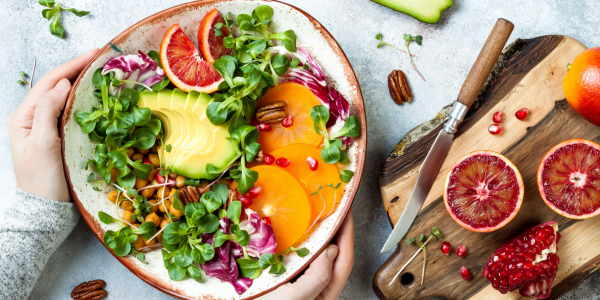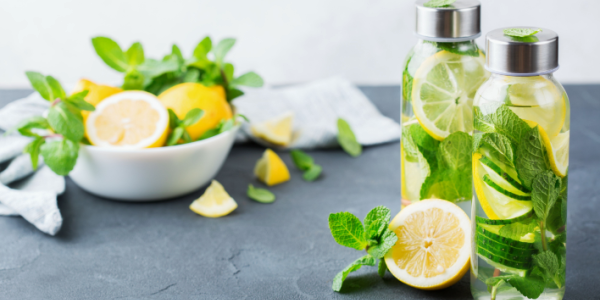
In nearly every form of media, “clean eating” has been trending. And like any diet plan, a clean eating meal plan has pros and cons.
When not taken to the extreme, clean eating may provide a helpful framework for enjoying more nutrient-rich meals. Continue reading to discover the truth about healthy clean eating recipes, including a 7-day clean eating meal plan with clean recipes for weight loss.
Clean Eating Meals: Pros & Cons
Clean eating lacks a concise definition and is largely open to interpretation. However, most experts agree that clean eating refers to foods in their least processed, most natural state. It most often mirrors a plant-based diet, a clean eating pattern rich in whole, raw foods and minimally processed products.
Considered a lifestyle by many, clean eating is a habit that often goes beyond diet to include cleaner living in all aspects of life. From food to cosmetics, a hallmark clean eaters live by is looking for ingredients they recognize instead of long ingredient lists littered with artificial chemicals and preservatives. Anything “refined” is generally off the table, too.
Pros: Avoiding Ultra-Processed Foods
A diet full of ultra-processed foods is associated with poor health outcomes, such as obesity, type 2 diabetes, and heart disease. While it’s unclear whether the processing or lack of nutrients in these foods is to blame, clean eating can help on both accounts.
One perk of clean eating is that it advises against processed foods. This can prompt people to look deeper into how food is processed and opt for fresher, healthier options. Eating foods in their more natural, raw form may help prevent disease and maintain health.
Focus on the clean eating diet trend has also forced many companies to rethink their product labels and create “clean” labels with cleaner ingredients. While some of these efforts are a simple change in marketing tactic, in some cases companies really are changing formulations and processes to respond to consumer demand.
Cons: May Lead to a Dangerous Mindset
For people with a history of eating disorders, clean eating can be dangerous and provide unrealistic expectations. Labeling foods as “clean” or “pure” can naturally lead to labeling others as “unclean” or “dirty,” which can quickly cause a healthy diet to turn into a restrictive one. This can create the perception that some packaged or prepared foods are somehow harmful or less healthy (which isn’t always true).
Another way of thinking that is worrying with self-proclaimed clean eaters is that many think “natural” equals healthy. This isn’t always true, especially since the word is used on labels as a marketing tactic. The term doesn’t have a clear definition according to the Food and Drug Administration (FDA), meaning companies may be able to use it at their convenience.
Research suggests clean eating social media may also be misleading. Instagram is thought to be especially suspect since diets can look picture-perfect while causing consumers to feel like they aren’t meeting an ideal standard of purity.
Blogs posts can also be a problem, with one study suggesting that “foods with clean eating claims contained the same amount of energy, sugar, and sodium as foods without those claims.”
Healthy Clean Eating Foods
Looking for healthy recipes? The following tips can help you with meal prep. Before reading through these lists, it’s important to remember that a clean eating plan doesn’t have to be perfect to be effective.
“Allowed” Clean Foods
The following foods are encouraged on a clean eating plan:
• Dairy, including milk, yogurt, cheese, or fortified alternatives)
• Grass-fed, pasture-raised, and organic products
• Fermented foods
• Healthy fats (such as olive oil)
• Herbs and spices
• Lean proteins (such as eggs, fresh or frozen seafood, or poultry)
• Legumes (like beans, peas, and lentils)
• Nuts, seeds, nut flours, and nut and seed butter blends
• Plenty of fresh fruits and vegetables
• Whole or ancient grains (such as whole-grain bread, brown rice, oats, or quinoa)
Discouraged Foods
The following foods are discouraged on a clean eating plan:
• Added sugars and salt
• Highly-processed snack foods
• Refined sugars and flours
Focus on cleaner ingredients doesn’t mean meal prep must take hours. In fact, many of your go-to weeknight recipes (like sheet pan, Instant Pot, or stir fry solutions) can be easily and slightly modified to fit into clean eating parameters.
Searching for recipes elsewhere? Try finding reputable sources, such as recipes designed by dietitians or other trusted health experts.
Clean Recipes for Weight Loss
If you want to lose weight, clean eating could be a good fit for you. Along with the big picture of health and wellness, clean eating can assist with other goals—such as weight loss.
Like any healthy diet, clean eating isn’t meant to be taken to the extreme; too much of a good thing—like clean eating—can be problematic. However, as a simple context for choosing high-quality foods, it can provide a helpful framework for making better diet decisions.
Working with a dietitian to create a healthy meal can ensure your clean eating isn’t too extreme. They can help design a diet that meets your lifestyle goals while also providing you with the nutrients you need.
7-Day Clean Eating Meal Plan
Don’t know where to begin with a clean eating diet? Start here! From easy weeknight dinner recipes to other meals and snacks, this meal plan has got you covered.
Day 1
• Breakfast: Overnight Oats
• Lunch: Rainbow Quinoa Salad
• Dinner: Southwestern Zucchini Noodle Bowl (cook and cube your own chicken breasts, and you can use fresh corn instead of canned if you’d like)
• Snack: Delicious Edamame Guacamole with raw vegetables
Day 2
• Breakfast: Cinnamon Apple Pancakes
• Lunch: Tuna Salad on lettuce leaves
• Dinner: Chicken Burrito Bowl Recipe
• Snack: Honey Drizzled Broiled Grapefruit
Day 3
• Breakfast: Savory Oatmeal
• Lunch: Greek Stuffed Peppers
• Dinner: Blackened Salmon with Creole Tomato Okra Stew (can use fresh tomatoes instead of canned)
• Snack: Chia Seed Pudding with berries
Day 4
• Breakfast: Mexican-Style Avocado Egg
• Lunch: Cheesy Quinoa with Grilled Chicken
• Dinner: Citrus Marinated Shish Kabobs
• Snack: Spiced & Baked Cinnamon Apples
Day 5
• Breakfast: Quinoa breakfast bowl
• Lunch: Stewed Italian White Beans
• Dinner: Vegetarian Cauliflower Taco with Grilled Vegetable Salad
• Snack: Healthy Banana Bread
Day 6
• Breakfast: Salmon with a Sunny-Side Up Egg
• Lunch: Superfood Mason Jar Salad
• Dinner: Authentic Chana Masala with Honey Herb Roasted Carrots
• Snack: Sesame Sugar Snap Peas
Day 7
• Breakfast: Greek yogurt parfait or yogurt bowl
• Lunch: Cucumber Sushi (with real crab meat instead of imitation)
• Dinner: Teriyaki Chicken Bowl (can be made with chicken thighs)
• Snack: Apple Nachos
Interested in clean eating but short on time? Many of the meal plans from bistroMD count as "clean eating" and can help you meet your goals when meal prep is minimal.
Clean Eating Meals and Recipes: The Conclusion
Rather than being a perfect eating pattern, clean eating can provide a helpful framework for food choices. Research suggests consuming processed food can contribute to many health problems, so focusing on more raw, whole, and plant-powered foods has its benefits.
If you’re worried about taking clean eating too far, working with a dietitian can ensure your meal plan meets your nutrient needs.






